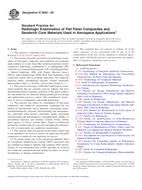Potrebujeme váš súhlas na využitie jednotlivých dát, aby sa vám okrem iného mohli ukazovať informácie týkajúce sa vašich záujmov. Súhlas udelíte kliknutím na tlačidlo „OK“.
ASTM E2662-09
Standard Practice for Radiologic Examination of Flat Panel Composites and Sandwich Core Materials Used in Aerospace Applications
Automaticky preložený názov:
Štandardné praktiky pre rádiologické vyšetrenie plochých kompozitov a sendvičových základných materiálov používaných v leteckom priemysle
NORMA vydaná dňa 1.6.2009
Informácie o norme:
Označenie normy: ASTM E2662-09
Poznámka: NEPLATNÁ
Dátum vydania normy: 1.6.2009
Kód tovaru: NS-45833
Počet strán: 5
Približná hmotnosť: 15 g (0.03 libier)
Krajina: Americká technická norma
Kategória: Technické normy ASTM
Anotácia textu normy ASTM E2662-09 :
Keywords:
aerospace composites, Computed Radiology (CR), digital detector array (DDA), digital radiology (DR), fiber-reinforced polymer matrix composites, flat panels, high modulus fibers, high performance composites, honeycomb core, laminates, nondestructive evaluation (NDE), nondestructive inspection (NDI), nondestructive testing (NDT), polymeric matrix composites (PMC), radiography (RT), radioscopy (RTR), sandwich core materials, sandwich constructions, structural sandwich constructions
Doplňujúce informácie
| Significance and Use | ||||||||||||||||||||||||||||||||||||||||||||||||||||||||
|
Radiologic examination may be used during product and process design optimization, on line process control, after manufacture inspection, and in service inspection. In addition to verifying structural placement, radiologic examination can be used in the case of honeycomb core materials to detect node bonds, core-to-core splices, and core-to-structure splices. Radiologic examination is especially well suited for detecting sub-surface flaws. The general types of defects detected by radiologic examination include blown core, core corrosion, damaged filaments, density variation, entrapped fluid, fiber debonding, fiber misalignment, foreign material, fractures, inclusions, microcracks, node bond failure, porosity/voids, and thickness variation. Factors that influence image formation and X-ray attenuation in radiologic examination , and which are relevant to interpreting the images for the conditions of interest, should be included in the examination request. Examples are, but not limited to, the following: laminate (matrix and fiber) material, lay-up geometry, fiber volume fraction (flat panels); facing material, core material, facing stack sequence, core geometry (cell size); core density, facing void content, adhesive void content, and facing volume percent reinforcement (sandwich core materials); overall thickness, specimen alignment, specimen geometry relative to the beam (flat panels and sandwich core materials). |
||||||||||||||||||||||||||||||||||||||||||||||||||||||||
| 1. Scope | ||||||||||||||||||||||||||||||||||||||||||||||||||||||||
|
1.1 This practice is intended to be used as a supplement to Practices E 1742, E 1255, and E 2033. 1.2 This practice describes procedures for radiologic examination of flat panel composites and sandwich core materials made entirely or in part from fiber-reinforced polymer matrix composites. Radiologic examination is: a) radiographic (RT) with film, b) Computed Radiography (CR) with Imaging Plate, c) Digital Radiology (DR) with Digital Detector Array’s (DDA), and d) Radioscopic (RTR) Real Time Radiology with a detection system such as an Image Intensifier. The composite materials under consideration typically contain continuous high modulus fibers (> 20 GPa), such as those listed in 1.4. 1.3 This practice describes established radiological examination methods that are currently used by industry that have demonstrated utility in quality assurance of flat panel composites and sandwich core materials during product process design and optimization, process control, after manufacture inspection, in service examination, and health monitoring. 1.4 This practice has utility for examination of flat panel composites and sandwich constructions containing but not limited to bismaleimide, epoxy, phenolic, poly(amide imide), polybenzimidazole, polyester (thermosetting and thermoplastic), poly(ether ether ketone), poly(ether imide), polyimide (thermosetting and thermoplastic), poly(phenylene sulfide), or polysulfone matrices; and alumina, aramid, boron, carbon, glass, quartz, or silicon carbide fibers. Typical as-fabricated geometries include uniaxial, cross ply and angle ply laminates; as well as honeycomb core sandwich constructions. 1.5 This practice does not specify accept-reject criteria and is not intended to be used as a means for approving flat panel composites or sandwich core materials for service. 1.6 To ensure proper use of the referenced standards, there are recognized nondestructive testing (NDT) specialists that are certified according to industry and company NDT specifications. It is recommended that a NDT specialist be a part of any composite component design, quality assurance, in service maintenance or damage examination. 1.7 This standard does not purport to address all of the safety concerns, if any, associated with its use. It is the responsibility of the user of this standard to establish appropriate safety and health practices and determine the applicability of regulatory limitations prior to use. |
||||||||||||||||||||||||||||||||||||||||||||||||||||||||
| 2. Referenced Documents | ||||||||||||||||||||||||||||||||||||||||||||||||||||||||
|
Odporúčame:
EviZak - všetky zákony vrátane ich evidencie na jednom mieste
Poskytovanie aktuálnych informácií o legislatívnych predpisoch vyhlásených v Zbierke zákonov od roku 1945.
Aktualizácia 2x v mesiaci !
Chcete vedieť viac informácii ? Pozrite sa na túto stránku.




 Cookies
Cookies
